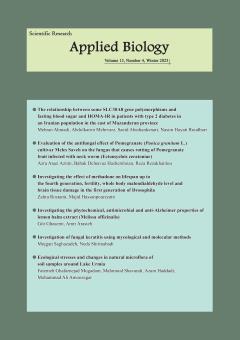Investigation of fungal keratitis using mycological and molecular methods
Subject Areas : biologyMojgan Saghazadeh 1 , Neda Shirinabadi 2
1 - Assistant Professor, Department of Microbiology, Faculty of Science, Qom Branch, Islamic Azad University, Qom, Iran
2 - MSc student, Department of Microbiology, Qom Branch, Islamic Azad University, Qom, Iran.
Keywords: fungal keratitis, mycological method, confocal microscopy, culture, PCR, cornea, eye diseases.,
Abstract :
Purpose: Fungal keratitis is a general term for a fungal disease of the cornea and can be caused by a wide variety of fungi. Keratitis is one of the causes of blindness worldwide. In this regard, the aim of the present research is to achieve an accurate and correct method in the diagnosis of fungal keratitis.
Materials and methods: From all patients with keratitis who referred to the Central Eye Bank of Iran from May 1394 to June 1395, in addition to direct examination and culture of a corneal chip sample, the diagnosis was first made by confocal scanning of the cornea, and the sensitivity and specificity of the diagnosis obtained from confocal scanning with Direct experiment and cultivation were compared. Then, using the colonyPCR method, PCR was performed from the colonies of Aspergillus and Fusarium fungi without DNA extraction, with the general primers of fungi (ITS1,4) and the specific primer of Aspergillus genus (ASPf1).
Findings: Out of 366 patients clinically suspected of having infectious keratitis, direct test and confocal scan results were positive in 17 patients and culture was
positive in 13 cases. 47.06% of the patients were workers. Fusarium genus was the most isolated (47.06%). The rest included Aspergillus (17.65%), Microsporum (5.88%) and Penicillium (5.88%).
Conclusion: Since the delay in the treatment of fungal keratitis causes corneal opacity, reduced vision and absolute blindness, timely diagnosis and rapid treatment of fungal keratitis is necessary.
1. Amirinia F, Shokohi T, Nowroozpoor Dailami K & Haghani I. Mycotic Keratitis: An Overview on Diagnosis and Treatment with a Focus on Epidemiology of the Disease in Iran. J Mazandaran Univ Med Sci. 2014; 24(119): 235-259. [in persian]
2. Rezaei Kanwi M, Jafarnejadi AA & Javadi MA. Diagnosis of two cases of acanthamoeba keratitis by confocal scanning and its successful treatment. Bina. 2013; 10(37): 118-123.
[in persian]
3. Fata S, Derakhshan A, Bolourian AA, Sedaghat MR, Khakhshour H, Afzalaghee M, Meshkat M, Najafzadeh M & Fata A. Mycotic Keratitis, A Study on Etiologic Agents, Predisposing Factors and the Result of Treatment among 44 Patients. Medical journal of mashhad university of medical sciences. 2010; 53(1): 16-25.
DOI: 10.22038/mjms.2010.5403[in persian]
4. Alshehri B & Palanisamy M. Evaluation of molecular identification of Aspergillus species causing fungal keratitis. Saudi Journal of Biological Sciences. 2020; 27(2): 751-756.
5. Ansari Z, Miller D & Galor A. Current thoughts in fungal keratitis: diagnosis and treatment. Curr Fung Infect Rep. 2013; 7: 209-18.
6. Behera HS & Srigyan D. Evaluation of polymerase chain reaction over routine microbial diagnosis for the diagnosis of fungal keratitis. Optometry and Vision Science. 2021; 98(3): 280-284.
7. Brown L, Leck AK, Gichangi M, Burton MJ & Denning DW. The global incidence and diagnosis of fungal keratitis. The Lancet Infectious Diseases. 2021; 21(3): e49-e57.
8. Jafarinasab MR, Feizi S, Yazdizadeh F, Rezaei Kanavi M & Moein HR. Aspergillus flavus keratitis after deep anterior lamellar keratoplasty. J Ophthalmic Vis Res. 2012; 7: 167-171.
9. Gunasekaran R, Janakiraman D, Rajapandian SGK, Appavu SP, Venkatesh PN & Prajna L. Periconia species-An unusual fungal pathogen causing mycotic keratitis. Indian Journal of Medical Microbiology. 2021; 39(1): 36-40.
10. Hoffman JJ, Burton MJ & Leck A. Mycotic keratitis—a global threat from the filamentous fungi. Journal of Fungi. 2021; 7(4): 273.
11. Hoffman JJ, Dart JK, De SK, Carnt N, Cleary G & Hau S. Comparison of culture, confocal microscopy and PCR in routine hospital use for microbial keratitis diagnosis. Eye. 2022; 36(11): 2172-2178.
12. Hung N, Yeh LK, Ma DHK, Lin HC, Tan HY & et al. Filamentous fungal keratitis in Taiwan: based on molecular diagnosis. Translational Vision Science & Technology. 2020; 9(8): 32-32.
13. Kuo MT, Chen JL, Hsu SL, Chen A & You HL. An omics approach to diagnosing or investigating fungal keratitis. International Journal of Molecular Sciences. 2019; 20(15): 3631.
14. Mokhtar WA, Hemeda S & Mokhtar GA. Utility of polymerase chain reaction for rapid diagnosis of paediatric fungal keratitis: A comparative study with conventional mycological work up. Microbes & Infectious Diseases. 2021; 2(1).
15. Ng JK, Fraunfelder FW & Winthrop KL. Review and update on the epidemiology, clinical presentation, diagnosis, and treatment of fungal keratitis. Current Fungal Infection Reports. 2013; 7: 293-300.
16. Raj N, Vanathi M, Ahmed NH, Gupta N, Lomi N & Tandon R. Recent perspectives in the management of fungal keratitis. Journal of Fungi. 2021; 7(11): 907.
17. Ting DS, Gopal BP, Deshmukh R, Seitzman GD, Said DG & Dua HS. Diagnostic armamentarium of infectious keratitis: A comprehensive review. The Ocular Surface. 2022; 23: 27-39.
18. Thomas PA. Current perspectives on ophthalmic mycoses. Clin Microbiol Rev. 2003; 16: 730-797.
19. Thomas PA & Kaliamurthy J. Mycotic keratitis: epidemiology, diagnosis and management. Clinical Microbiology and Infection. 2013; 19(3): 210-220.


